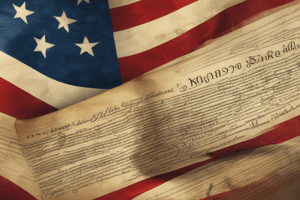Podcast
Questions and Answers
What was a major factor that led to the Constitutional Convention of 1787?
What was a major factor that led to the Constitutional Convention of 1787?
- The need to create a more democratic system of government
- The desire to declare independence from Great Britain
- The failure of the Articles of Confederation to provide a strong central government (correct)
- The influence of European monarchies on American politics
What is a key feature of federalism?
What is a key feature of federalism?
- The concentration of power at the national level
- The division of power between national and state governments (correct)
- The absence of local governments
- The supremacy of state governments over the national government
What was a major consequence of the shift toward increased national power since 1937?
What was a major consequence of the shift toward increased national power since 1937?
- The decline of state governments
- The growth of the Bill of Rights
- The reduction of the president's powers
- The expansion of the national government's authority (correct)
What is a key feature of the amendment process?
What is a key feature of the amendment process?
What is a key function of the Bill of Rights?
What is a key function of the Bill of Rights?
What is a key feature of the Fourteenth Amendment?
What is a key feature of the Fourteenth Amendment?
What is a key challenge faced by members of Congress?
What is a key challenge faced by members of Congress?
What is a key feature of bureaucracies in the United States?
What is a key feature of bureaucracies in the United States?
Study Notes
The Road to the Constitutional Convention of 1787
- Major political and historical developments that led to the Constitutional Convention of 1787 included:
- Weaknesses of the Articles of Confederation
- Shays' Rebellion
- Nationalist sentiment
- Economic instability
Federalism and National Power
- Federalism is a system of government that divides power between a central authority and smaller units (states, provinces, etc.)
- Federalism limits national power by:
- Distributing authority among multiple levels of government
- Ensuring that power is not concentrated in one entity
- Evolution of federalism in the United States:
- From the Founding to the twentieth century, federalism oscillated between national and state-centric approaches
- Shift towards increased national power since 1937
The US Constitution
- Major provisions of the US Constitution:
- Separation of powers
- Checks and balances
- System of federalism
- Representative democracy
- Protection of individual rights
Balancing Representation and Governance
- The framers attempted to balance representation with effective governance by:
- Creating a bicameral legislature
- Establishing a system of checks and balances
- Ensuring that power is distributed among multiple branches of government
The Amendment Process
- The amendment process allows the Constitution to evolve over time by:
- Providing a mechanism for change
- Ensuring that the Constitution remains relevant and adaptable
The Bill of Rights
- Origins of the Bill of Rights:
- Response to anti-Federalist concerns about individual rights
- First 10 amendments to the Constitution
- Purpose of the Bill of Rights:
- Protect citizens from improper governmental actions
- Ensure individual liberties and freedoms
The Fourteenth Amendment and Nationalization of the Bill of Rights
- The Fourteenth Amendment (1868) nationalized the Bill of Rights by:
- Extending federal protections to state citizens
- Ensuring that states cannot infringe on individual rights
Precedent and Interpretation
- Precedent and interpretation continue to shape the Bill of Rights by:
- Informing judicial decisions
- Evolving the understanding of individual rights
Civil Rights and Collective Action
- Civil rights relate to collective action in the United States by:
- Ensuring equal protection and opportunities for all citizens
- Facilitating social and political change through collective action
The US Congress
- Diverse views and interests represented in Congress:
- Geographic, ideological, and demographic differences
- Organization of the US Congress:
- Bicameral legislature with Senate and House of Representatives
- Committee system and leadership structures
The Presidency
- Constitutional origins and powers of the presidency:
- Established in Article II of the Constitution
- Includes executive, legislative, and judicial powers
- Formal and informal resources of the presidency:
- Executive powers, such as veto authority and executive orders
- Informal powers, such as persuasion and negotiation
Bureaucracies and Effective Governance
- Bureaucracies facilitate effective governance by:
- Implementing laws and policies
- Establishing rules and regulations
- Settling disputes and providing public services
The Executive Branch
- Structure of the executive branch:
- Includes executive departments and agencies
- Organized to facilitate implementation of laws and policies
The Judiciary
- Organization of America's courts:
- Hierarchical system with Supreme Court at the apex
- Includes federal and state courts
- Role of judges in shaping public policy:
- Interpreting laws and the Constitution
- Establishing precedents and influencing policy decisions
Common Law and Precedents
- Common law and precedents shape judicial decisions by:
- Providing a framework for legal interpretation
- Informing judicial rulings and opinions
Judicial Review
- Significance of judicial review:
- Ensures that laws are consistent with the Constitution
- Provides a check on legislative and executive power
Public Opinion and Elections
- Public opinion can be understood at:
- Aggregate level (collective attitudes and opinions)
- Individual level (personal attitudes and beliefs)
- Elections in the United States function as:
- Formal institutions for making collective decisions
- Mechanisms for holding elected officials accountable
Studying That Suits You
Use AI to generate personalized quizzes and flashcards to suit your learning preferences.
Description
Explore the key events leading to the Constitutional Convention, federalism, and its evolution in the United States. Understand how the Constitution balances representation and national power.




